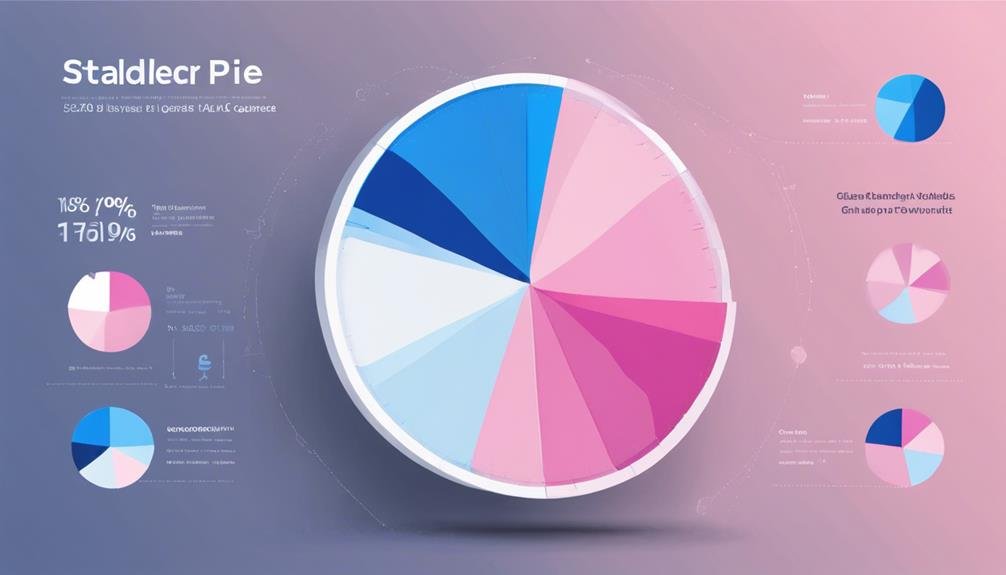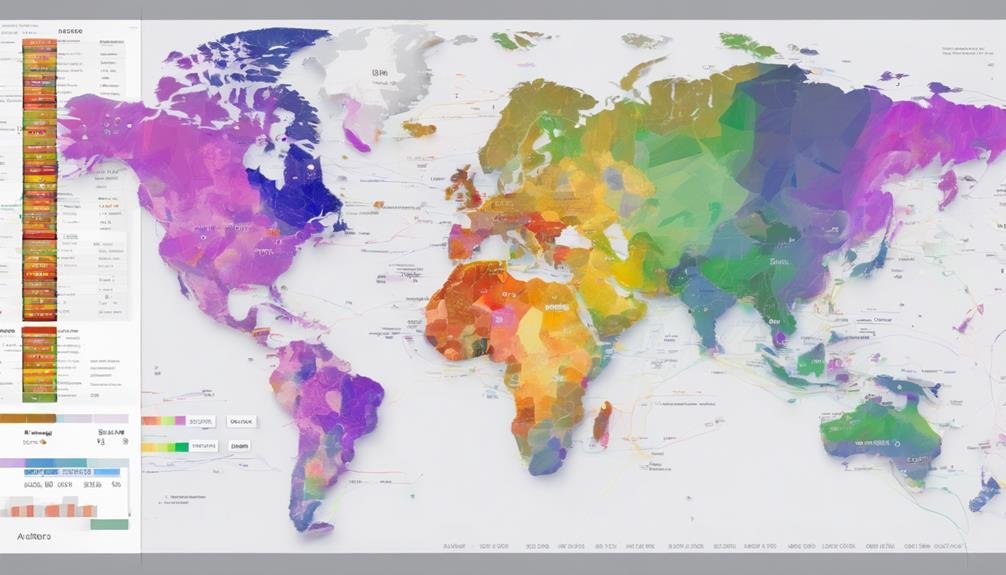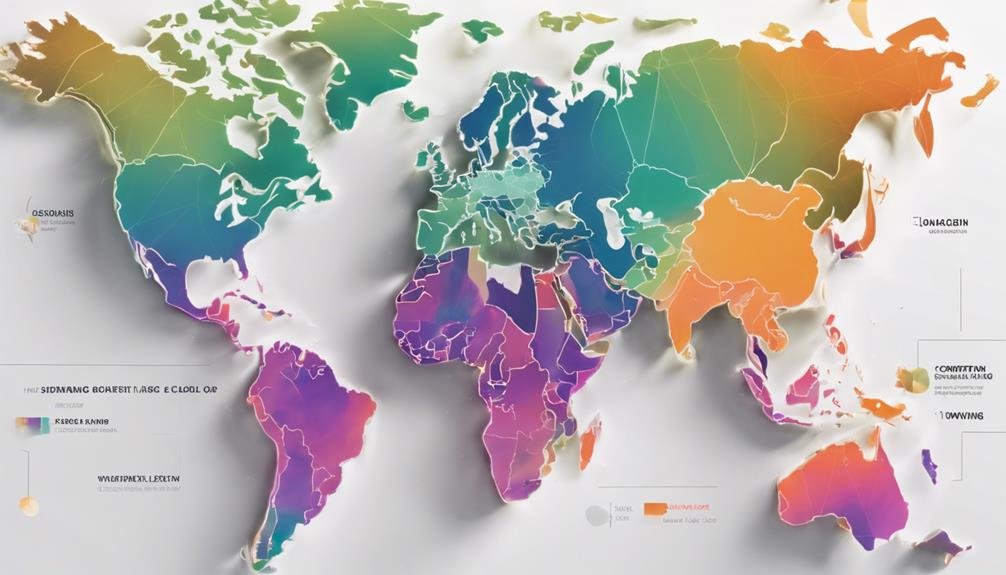Discover key insights on stablecoin user demographics worldwide. The largest age group falls between 25-34, with significant representation from 18-24 and 35-44. Gender distribution stands at 60% male and 40% female. Users span varied income brackets, including high earners and those below $50,000. Educational backgrounds range from finance to engineering, shaping investment behaviors. User engagement is high in North America and Europe, with preferences for DeFi and centralized exchanges. Trust in stablecoin issuers, transparency, and stability are paramount. Future projections indicate over 100 million users by 2025, driven by younger generations and technological advancements. Discover more insights ahead.
Table of Contents
Brief Overview of Demographic Analysis Of Stablecoin Users Worldwide
- The largest stablecoin user segment is the 25-34 age group.
- Gender distribution: 60% male, 40% female globally.
- Diverse income backgrounds, including high-income individuals.
- Educational backgrounds: finance, economics, tech degrees.
- Trust factors: issuer transparency, stability, and predictability.
Global Distribution of Stablecoin Users
Globally distributed, stablecoin users exhibit notable adoption rates in North America, Europe, and Asia. In North America, users hold a substantial market share of stablecoins, attracted by clear regulations and easy access to cryptocurrency markets. Europe has also witnessed a rise in stablecoin users, with a growing market share driven by regulatory changes and the increasing popularity of decentralized finance (DeFi) platforms. Similarly, Asia, including countries like China and South Korea, boasts a strong presence of stablecoin users, showcasing the region’s active involvement in cryptocurrency.
These regions represent key players in the stablecoin market, each contributing significantly to the global distribution of users. North America’s market share is bolstered by regulatory clarity. At the same time, Europe’s growth is fueled by regulatory developments and the expansion of DeFi platforms. At the same time, Asia’s market share reflects a vibrant cryptocurrency ecosystem, with countries like China and South Korea leading the way in stablecoin adoption. The market share of stablecoin users in these regions highlights their importance in driving the widespread use and acceptance of stablecoins worldwide.
Age Demographics of Stablecoin Users

In examining the demographics of stablecoin users, a predominant age group emerges as the largest segment actively participating in the market. The age group of 25-34 stands out as the primary cohort engaging with stablecoins in the crypto market. Following closely behind, users aged 18-24 and 35-44 also show significant involvement in this sector. Although less represented, older age groups like 45-54 and 55+ still play a role in shaping the demographic landscape of stablecoin users.
The surge in crypto awareness and adoption has attractively drawn younger individuals, particularly those between 18-24, towards utilizing stablecoins. The age demographics of stablecoin users exhibit diversity across different regions, underscoring the varied nature of the global stablecoin user base. This shift in age distribution within the stablecoin market reflects the evolving dynamics of the crypto landscape. It hints at a broader adoption in the future.
Gender Breakdown Among Stablecoin Users

With males comprising 60% and females comprising 40% of stablecoin users worldwide, a discernible gender imbalance is apparent in the demographic breakdown. This imbalance indicates that the stablecoin market is currently skewed toward male users. Despite efforts to increase female participation, the gap remains significant. Market research underlines the importance of diversifying the user base to enhance market cap and engagement.
Understanding the gender breakdown among stablecoin users is essential for developing targeted marketing strategies that resonate with both male and female audiences. By recognizing this disparity, companies can tailor their outreach to attract a more diverse user demographic, potentially leading to a more inclusive and expansive market. As the market continues to evolve, addressing gender imbalances within stablecoin user demographics will be vital to fostering broader adoption and ensuring sustained growth.
Income Levels of Stablecoin Users

Stablecoin users come from diverse economic backgrounds with varying income levels. This diversity is essential in shaping investment decisions and risk management strategies within the cryptocurrency market. Understanding how income influences user behavior provides valuable insights into the broader stablecoin ecosystem and its impact on financial inclusion.
User Income Distribution
Exploring the income levels of stablecoin users reveals a diverse range of earnings, with a notable concentration falling within the middle-income bracket. In the stablecoin market, a significant percentage of users earn between $50,000 to $100,000 annually. Additionally, high-income individuals, with earnings surpassing $100,000, are also part of the user demographic.
Conversely, some users have incomes below $50,000, showcasing the varied income distribution within the stablecoin community. These income levels are essential in shaping users’ investment behaviors and risk tolerance within the cryptocurrency market. Understanding the income diversity among stablecoin users provides valuable insights into their financial backgrounds and influences their engagement with digital assets.
Economic Background Diversity
A diverse range of income levels characterizes the economic backgrounds of stablecoin users, reflecting a mix of lower, middle, and higher income brackets. Regarding Tether (USDT) and other stablecoins, income diversity is vital to the user base. Here are some key points to keep in mind:
- Stablecoin users show a varied distribution across different income groups.
- Data indicates that individuals from lower income brackets are also active users of stablecoins.
- Middle-income groups globally represent a significant portion of stablecoin adopters.
- The appeal of stablecoins transcends income boundaries, attracting users from all economic strata.
- Regardless of their income levels, users find the accessibility and utility of stablecoins highly attractive.
Educational Background of Stablecoin Users

Furthermore, diverse educational backgrounds, encompassing finance, economics, and computer science degrees, are prevalent among stablecoin users. With the intricate nature of crypto assets, having a solid foundation in these fields equips users with the necessary knowledge to navigate the complexities of stablecoins effectively. Many individuals within this demographic also possess technical expertise based on their understanding of blockchain technology and decentralized finance.
It is expected to find stablecoin users with postgraduate degrees, indicating a higher level of education within this community. The alignment between the educational backgrounds of stablecoin users and the sophisticated financial and technological concepts involved in utilizing stablecoins is evident. Additionally, backgrounds in mathematics, engineering, and related disciplines are frequently seen among stablecoin users, highlighting the importance of analytical skills in managing digital assets. This educational diversity underscores the need for a multidisciplinary approach when engaging with stablecoins.
Geographic Spread of Stablecoin Users

Stablecoin users are dispersed globally, with notable adoption rates in Asia, Europe, and North America.
- Asia: Leading in stablecoin usage, countries like China, Singapore, and South Korea exhibit high adoption rates, with Tether (USDT) being a popular choice.
- Europe: Countries like the UK, Switzerland, and Germany have a substantial user base for stablecoins, reflecting a growing trend in the region.
- North America: The United States and Canada show increasing numbers of stablecoin users attracted to platforms such as Coinbase and Gemini for their transactions.
- Regulatory Environment: The varying regulatory landscapes influence the distribution of stablecoin users globally, impacting the ease of adoption and market growth.
- Financial Literacy: Levels of financial knowledge and understanding of blockchain technology also play a role in the geographic spread of stablecoin users, shaping adoption rates in different regions.
Usage Patterns of Stablecoin Users

Exploring how stablecoin users engage with digital assets sheds light on their distinct usage patterns and behaviors. Tether (USDT), a popular stablecoin, plays a significant role in this landscape. Users mainly fall within the 25-34 age group, representing 31% of the user base, with males constituting about 70% of the total users. North American and European users are particularly active in utilizing stablecoins for various purposes.
Additionally, many stablecoin users have a higher level of education, often holding at least a bachelor’s degree. Individuals with backgrounds in finance, technology, and cryptocurrency trading are more inclined to engage with stablecoins. These usage patterns reflect a diverse user base with a strong interest in the functionalities and benefits that stablecoins like Tether offer in the digital asset ecosystem.
Platform Preferences Among Stablecoin Users

When selecting platforms for transactions, stablecoin users mostly favor decentralized finance (DeFi) platforms. These platforms offer users greater control over their funds and access to various financial services. Here are some insights into the platform preferences among stablecoin users:
- DeFi protocols: The decentralized nature of these platforms aligns with the principles of many stablecoin users who value autonomy and security.
- Centralized exchanges: Despite the rise of DeFi, centralized exchanges remain popular for their high liquidity and user-friendly interfaces.
- Peer-to-peer (P2P) platforms: Some users prefer direct transactions without intermediaries, seeking increased privacy and lower fees.
- Lending and borrowing platforms: Within the DeFi ecosystem, stablecoin users often engage in lending and borrowing activities to earn interest or access leverage.
- Virtual asset service providers (VASPs) and wallets are essential for storage and trading, providing secure environments for managing stablecoin assets effectively.
Understanding these preferences sheds light on how stablecoin users interact with different platforms for their financial needs.
Trust and Perception Among Stablecoin Users

Prioritizing trust and reliability in the stablecoin issuer is essential for users in the stablecoin ecosystem. Regarding stablecoins like Tether (USDT), users place a high value on perceiving these assets as safe havens. The trust in stablecoin issuers is influenced by transparency, auditability, stability, and predictability in value. Users feel more secure when they can easily verify the compliance of stablecoins with regulations.
This positive perception enhances overall trust among stablecoin users. Trust plays a vital role in users’ decision-making process when choosing which stablecoin to engage with. Stablecoin issuers must prioritize building trust through clear communication, regular audits, and compliance with regulatory standards to maintain a positive perception among users. Trustworthiness is a cornerstone of the stablecoin ecosystem, shaping users’ preferences and behaviors.
Future Growth Prospects for Stablecoin Users

As stablecoin user adoption trends continue to rise exponentially, the global market potential for these digital assets is expanding rapidly. Emerging user segments, such as female and younger users, are poised to contribute significantly to the growth of the stablecoin ecosystem. Understanding these dynamics can provide valuable insights for companies looking to capitalize on the diverse user base and drive future development in the stablecoin market.
User Adoption Trends
With a projected global user base exceeding 100 million by 2025, the future growth prospects for stablecoin users are promising, particularly among younger demographics and female participants. As the adoption of stablecoins continues to rise, several trends are shaping the landscape:
- Asian users, especially in China, are leading in adopting stablecoins.
- Younger generations show a preference for using stablecoins in various financial activities.
- Female participation in the stablecoin ecosystem is increasing, promoting inclusivity.
- Stablecoin users tend to have higher education levels, indicating a tech-savvy user base.
- Continued growth in the adoption of stablecoins suggests a shift towards digital financial solutions worldwide.
Global Market Potential
The global market potential for stablecoin users’ future growth prospects remains significant, driven by factors like regulatory clarity and technological advancements. With stablecoins like Tether (USDT) gaining traction, the potential for increased adoption is evident across regions such as Asia, Europe, and North America. Regulatory frameworks that provide a clear path for stablecoin usage and advancements in blockchain technology are paving the way for a broader user base.
Additionally, the appeal of stablecoins in facilitating cross-border transactions and promoting financial inclusion is attracting interest from emerging markets. As partnerships between stablecoin issuers, fintech companies, and traditional financial institutions continue to evolve, the market reach of stablecoins is poised to expand, offering opportunities for diverse demographics to access digital financial services.
Emerging User Segments
Stablecoin user demographics are evolving, with emerging segments such as institutional investors, retail users, cross-border businesses, freelancers, and remittance recipients driving future growth prospects for stablecoin adoption.
- Institutional investors seek exposure to crypto assets.
- Retail users find stablecoins a secure store of value amidst market volatility.
- Cross-border businesses opt for stablecoins for fast and cost-effective international transactions.
- Freelancers and gig economy workers rely on stablecoins for efficient payment settlements.
- Remittance recipients in developing countries are turning to stablecoins for their accessibility and stability.
Frequently Asked Questions
What Is the Most Widely Used Stablecoin?
Tether (USDT) reigns as the most widely used stablecoin in the crypto world, boasting a market cap of over $110.89 billion. Its dominance in the stablecoin market, exceeding 70%, showcases its paramount role in stablecoin adoption.
What Is the Market Share of Tether?
Surprisingly, Tether dominates the stablecoin market with about 70% share. Its market cap, hitting $110.89 billion, solidifies its position. Tether’s USDT token is vital for global crypto transactions, emphasizing its significance.
How Stable Is Usdc?
USDC is highly stable, backed by assets like US dollars, commercial paper, and treasuries. The reserve undergoes regular audits for transparency. With a market cap surpassing $33.42 billion, USDC’s reliability and liquidity make it a favored choice in DeFi.
How Safe Is Dai?
Dai’s security is solid, supported by decentralized collateralization and a flawless track record since 2015. Earn interest with Dai Savings Rate. Transparent smart contracts and community governance guarantee your safety and peace of mind.
Conclusion
To sum up, the global stablecoin user demographics reveal a diverse and growing market. While age, gender, income, and education play a role in user preferences, the future growth prospects for stablecoins remain promising. As users continue to trust and adopt stablecoins across various platforms, the potential for widespread adoption and usage is evident. With a clear understanding of user patterns and preferences, the stablecoin market is poised for continued expansion and innovation.




